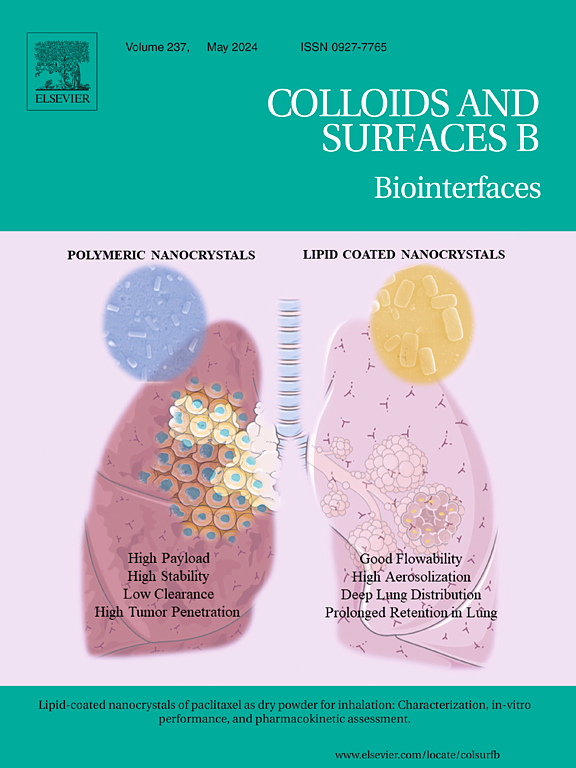基于新型希夫碱化合物的锌离子检测和HeLa细胞下转换和nir激发上转换发光双模传感平台
IF 5.4
2区 医学
Q1 BIOPHYSICS
引用次数: 0
摘要
我们成功地通过一步法合成了两种新型的含硅氧烷的希夫碱化合物pBSIA和oBSIA。这些化合物表现出显著的上转换发光特性,有效地将近红外(NIR)光转化为蓝光。基于oBSIA,我们开发了一个集成下转换荧光和nir激发上转换发光的双模传感平台,实现了HeLa细胞的Zn2+检测和nir激发成像。实验结果表明,与未配合的oBSIA相比,oBSIA- zn2 +配合物的荧光强度增强了近30倍,绝对量子产率提高了500 %以上。这种配体增强的荧光机制支持定性和定量检测Zn2+。此外,该探针具有低细胞毒性和优异的稳定性,有助于有效渗透到活的HeLa细胞中,并在近红外激发下实现无创上转换成像。这种方法有效地解决了传统荧光成像技术的局限性。所开发的希夫碱化合物是生物系统中荧光传感的有力工具。它们也为设计具有生物传感和生物成像潜在应用的近红外上转换生物活性分子提供了新的机会。本文章由计算机程序翻译,如有差异,请以英文原文为准。
A dual-mode sensing platform based on novel Schiff base compounds for zinc ion detection and HeLa cell imaging via downconversion and NIR-excited upconversion luminescence
We successfully synthesized two novel siloxane-containing Schiff base compounds, pBSIA and oBSIA, via a one-step process. These compounds exhibited remarkable upconversion luminescence properties, efficiently converting near-infrared (NIR) light into blue emission. Based on oBSIA, we developed a dual-mode sensing platform that integrates downconversion fluorescence and NIR-excited upconversion luminescence, enabling Zn2+ detection and NIR-excited imaging of HeLa cells. Experimental results demonstrated that the oBSIA-Zn2+ complex exhibited a nearly 30-fold enhancement in fluorescence intensity and over 500 % increase in absolute quantum yield compared to uncomplexed oBSIA. This ligand-enhanced fluorescence mechanism supports both qualitative and quantitative Zn2+ detection. Furthermore, the probe exhibited low cytotoxicity and excellent stability, facilitating efficient penetration into living HeLa cells and enabling noninvasive upconversion imaging under NIR excitation. This approach effectively addresses the limitations of conventional fluorescence imaging techniques. The developed Schiff base compounds serve as a powerful tool for fluorescence sensing in biological systems. They also offer new opportunities for designing NIR upconversion bioactive molecules with potential applications in biosensing and bioimaging.
求助全文
通过发布文献求助,成功后即可免费获取论文全文。
去求助
来源期刊

Colloids and Surfaces B: Biointerfaces
生物-材料科学:生物材料
CiteScore
11.10
自引率
3.40%
发文量
730
审稿时长
42 days
期刊介绍:
Colloids and Surfaces B: Biointerfaces is an international journal devoted to fundamental and applied research on colloid and interfacial phenomena in relation to systems of biological origin, having particular relevance to the medical, pharmaceutical, biotechnological, food and cosmetic fields.
Submissions that: (1) deal solely with biological phenomena and do not describe the physico-chemical or colloid-chemical background and/or mechanism of the phenomena, and (2) deal solely with colloid/interfacial phenomena and do not have appropriate biological content or relevance, are outside the scope of the journal and will not be considered for publication.
The journal publishes regular research papers, reviews, short communications and invited perspective articles, called BioInterface Perspectives. The BioInterface Perspective provide researchers the opportunity to review their own work, as well as provide insight into the work of others that inspired and influenced the author. Regular articles should have a maximum total length of 6,000 words. In addition, a (combined) maximum of 8 normal-sized figures and/or tables is allowed (so for instance 3 tables and 5 figures). For multiple-panel figures each set of two panels equates to one figure. Short communications should not exceed half of the above. It is required to give on the article cover page a short statistical summary of the article listing the total number of words and tables/figures.
 求助内容:
求助内容: 应助结果提醒方式:
应助结果提醒方式:


